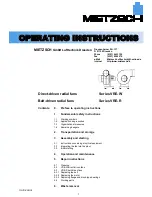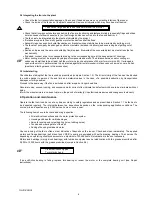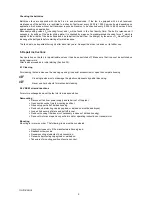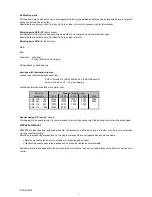
3.2 Integrating the fan into the plant
Check the fan for transportation damages. Check and, if needed, ensure non-contacting rotation of the runner.
Check the inside of the fan and of the plant connected. Remove all objects which may have been left behind.
Take care of forgotten tools and residual material in particular.
Check that all components before and behind the fan are functioning and fastened reliably (especially flaps and slides,
but also vanes of elbow channels etc.) so that foreign bodies cannot run into the fan and destroy it.
The fan has to be integrated into the plant as indicated by the project.
If intakes are open to the vicinity guards or protective devices shall be fixed.
Assembly requires even horizontal foundations or brackets whose stability has to be warranted by building work.
The fan must principally be arranged on vibration isolators (included in delivery) and secured against getting out of
place.
Suction and pressure lines are connected by flexible pipes. Elements of the connected plant must not stress the fan
mechanically.
If needed, connect a line for condensate draining to the corresponding bore at the deepest part of housings.
Motor cooling must not be impaired by adjacent components and walls. The distance between motor cooling air
entrance and wall has to be at least half the motor size (such as distance of 40 mm for motor size 80). If arranged in
open air the motor in particular has to be protected against direct atmospheric influences such as ice, snow, and hail
(weather protecting sleeve in the accessories).
3.3 Initial starting
Check before starting that the fan is used as prescribed (compare Section 1.2). The direct vicinity of the fan must be blocked
to exclude danger to persons' life and limb and material values in the case of a possible destruction by transportation
damages or foreign bodies.
Proceed in the same way if the fan is switched on after a repair or longer downtime.
Abnormal noise, uneven running, and excessive motor current often indicate fan defects which have to be eliminated without
delay.
Inform the manufacturers in cases of claims in the period of warranty. Unauthorized measures and changes void warranty.
4. Operation and maintenance
Operate the fan that it can be run at any time according to safety regulations and as prescribed in Section 1. The fan has to
be inspected regularly. The interval between two inspections depends on the corresponding application conditions. The
minimum is an inspection every 5,000 service hours or once a year.
The following items have to be checked during inspection:
All electrical connections and the motor protection system
Housing and base for visible damages
Smooth running and noise (bearing noise, rubbing noise)
Tension and wearing state of the belt
Soiling of housing inside and motor
Uneven running of the fan is often a clear indication of deposits on the runner. Check and clean immediately. The applied
motors and flange bearings (belt driven fans VRE-R) usually are equipped with self-lubricating bearings. Their service life
depending on operating conditions amounts to a maximum of 50,000 hours. Relubrication is thus not necessary.
Motors and bearings (mainly block bearings) with lubrication nipples require relubrication with the grease prescribed after
5,000 to 12,000 hours with the grease prescribed (compare Section 5.4).
Clean lubrication nipples.
Turn rotor by hand.
If an antifriction bearing is failing, replace this bearing or renew the motor or the complete bearing unit (see Repair
instructions).
!
4
OI-VRE 05/02


























